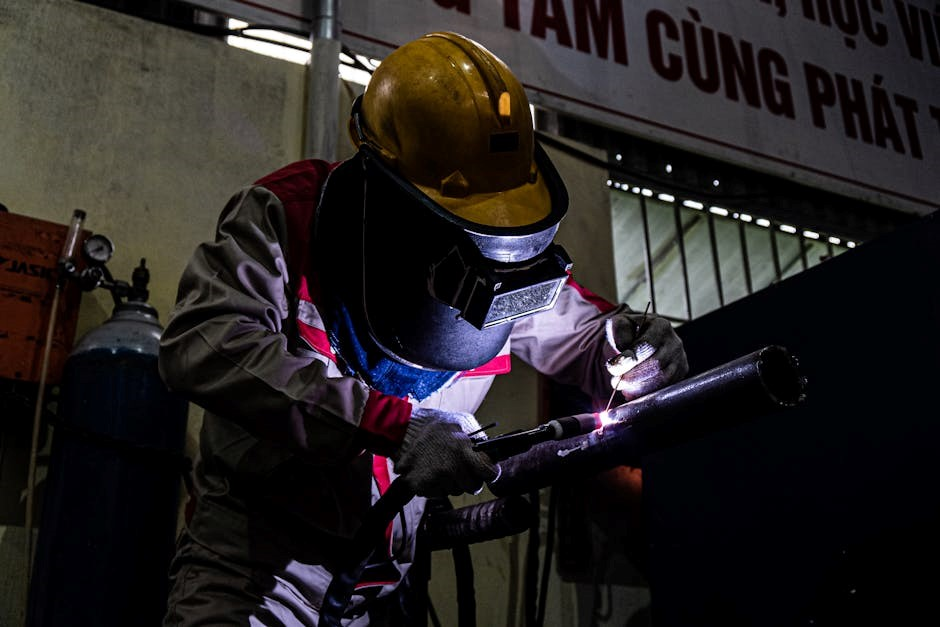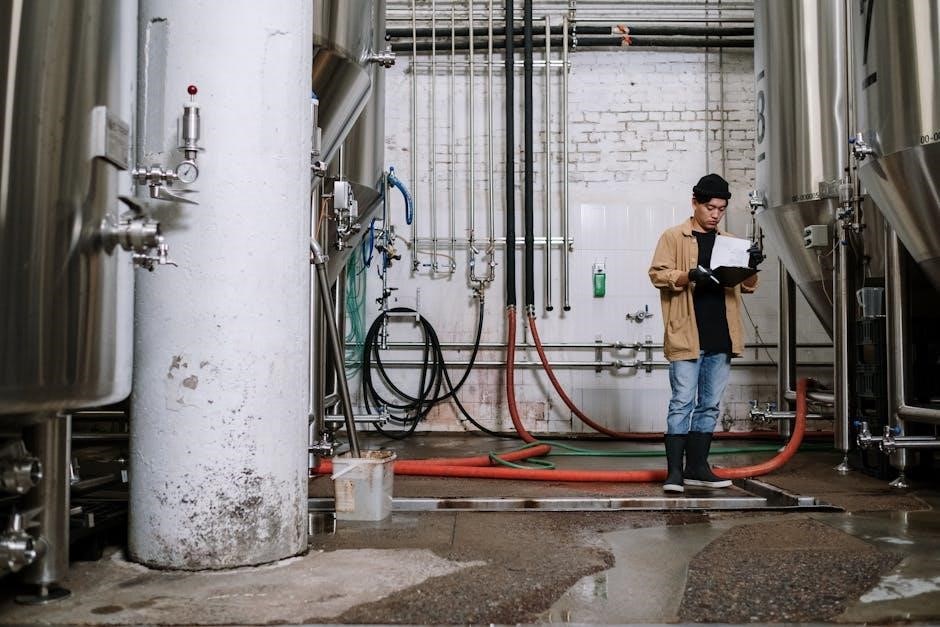Manual Pipe Bender: A Comprehensive Guide
A manual pipe bender is a versatile tool for bending pipes and tubes‚ ideal for tight spaces and precise control. It’s cost-effective‚ durable‚ and suitable for various materials like copper‚ aluminum‚ and steel. Perfect for professionals and DIY projects‚ it offers a practical solution for creating custom bends efficiently.
A manual pipe bender is a versatile‚ cost-effective tool designed to bend pipes and tubes with precision and control. Perfect for professionals and DIY enthusiasts‚ it’s widely used in plumbing‚ HVAC‚ and small-scale fabrication. Its simplicity and portability make it ideal for tight spaces and custom projects. Whether bending copper‚ aluminum‚ or steel‚ a manual pipe bender offers a practical solution for creating accurate‚ consistent bends without the need for expensive machinery.
What is a Manual Pipe Bender?
A manual pipe bender is a hand-operated tool used to bend pipes and tubes into desired shapes. It works by applying force to the tube‚ forming precise bends without damaging the material. Designed for various materials like copper‚ aluminum‚ and steel‚ it’s a essential tool for plumbing‚ HVAC‚ and fabrication projects. Its compact design and ease of use make it a popular choice for professionals and DIY enthusiasts‚ offering a cost-effective solution for custom bends;
Types of Manual Pipe Benders
Manual pipe benders come in various designs‚ catering to different needs. The most common types include handheld benders for small-scale projects‚ lever-operated benders offering greater force‚ and rotary-draw benders for precise‚ complex bends. Each type is suited for specific materials and applications‚ ensuring versatility and efficiency in bending tasks.
Design and Operation of Manual Pipe Benders
Manual pipe benders feature sturdy frames‚ interchangeable dies‚ and ergonomic handles. Operation involves clamping the tube and applying force to achieve precise bends‚ ensuring durability and accuracy.
Key Components of a Manual Pipe Bender
A manual pipe bender consists of a rigid frame‚ interchangeable bending dies‚ a clamping system‚ and an ergonomic handle. The frame provides stability‚ while the dies determine the bend radius. The clamping system secures the tube‚ ensuring precise alignment. The handle allows for manual force application‚ enabling controlled bending. These components work together to deliver accurate and consistent bends in various materials like copper‚ aluminum‚ and steel pipes‚ making it essential for professionals and DIY enthusiasts alike.
How to Operate a Manual Pipe Bender
Operating a manual pipe bender involves clamping the tube into position and using leverage to bend it. Start by selecting the appropriate bending die for your tube size. Secure the tube firmly in the clamping assembly‚ ensuring proper alignment with the die. Apply steady‚ controlled force to the handle to create the desired bend. Use a fulcrum for added leverage if needed. Once the bend is complete‚ carefully release the pressure and remove the tube. Always follow safety guidelines to avoid damage or injury.
Measuring and Marking the Tube for Bending
Accurate measuring and marking are crucial for precise bending. Use a tape measure to determine the desired bend location and angle. Mark the tube with a pencil or marker‚ ensuring the measurement aligns with the bending die. Double-check the markings to avoid errors. Proper alignment ensures the bend is made correctly. If needed‚ use a protractor or template for complex angles. Clean and dry the tube before marking to ensure clear visibility. This step ensures a professional and accurate result for your project;

Applications of Manual Pipe Benders
Manual pipe benders are essential for plumbing‚ HVAC‚ and DIY projects. They enable precise tube bending for custom fabrication‚ ideal for creating smooth curves in various materials and applications.
Common Uses in Plumbing and HVAC
In plumbing and HVAC systems‚ manual pipe benders are indispensable for creating precise bends in copper‚ aluminum‚ and steel pipes. They are often used to install or repair water supply lines‚ gas lines‚ and ductwork. By enabling custom bends without the need for welding‚ manual benders save time and reduce material waste. Their portability and ease of use make them ideal for tight spaces and on-site adjustments‚ ensuring efficient and reliable system installations and maintenance.
DIY Projects and Small-Scale Fabrication
Manual pipe benders are highly popular among DIY enthusiasts and small-scale fabricators for their versatility and affordability. They allow users to create custom bends for projects like bicycle frames‚ furniture‚ and small machinery. Portable and easy to use‚ these tools enable precise control over pipe shapes‚ making them ideal for crafting unique designs. Whether it’s bending copper pipes for a homemade trailer or creating artistic metalwork‚ manual benders empower creators to bring their visions to life with minimal equipment and maximum creativity.
Industrial Applications
Manual pipe benders are widely used in industrial settings for their precision and reliability. They are essential in manufacturing‚ shipbuilding‚ and construction for bending pipes in tight spaces. These tools are ideal for handling materials like steel and stainless steel‚ ensuring consistent and accurate bends. Their durability and versatility make them a preferred choice for industries requiring frequent pipe modifications. Whether for HVAC systems or complex machinery‚ manual pipe benders deliver efficient solutions‚ ensuring high-quality results in demanding environments.
Pros and Cons of Manual Pipe Benders
Manual pipe benders are cost-effective‚ portable‚ and offer precise control‚ making them ideal for small-scale projects. However‚ they require physical effort and may lack efficiency for complex bends.
Advantages of Using a Manual Pipe Bender
Manual pipe benders are cost-effective‚ lightweight‚ and easy to use‚ making them ideal for small-scale projects and tight spaces. They provide precise control over bends‚ ensuring accuracy and consistency. With no electricity required‚ they are portable and suitable for on-site work. Additionally‚ manual benders are durable‚ require minimal maintenance‚ and are versatile for various materials like copper‚ aluminum‚ and steel. Their simplicity also reduces the risk of mechanical failure‚ making them a reliable choice for professionals and DIY enthusiasts alike.
Limitations and Challenges
Manual pipe benders are limited by their physical operation‚ requiring manual strength and effort‚ especially for larger or thicker pipes. They are less efficient for mass production compared to powered benders. Additionally‚ creating complex or precise multiple bends can be challenging‚ requiring skill and experience. The tool’s portability and simplicity are offset by the time and effort needed for intricate projects‚ making them less suitable for industrial-scale applications or repetitive tasks.
Choosing the Right Manual Pipe Bender
Selecting the right manual pipe bender involves considering pipe size‚ material‚ and the type of bends required. Ensure compatibility with your project needs for optimal performance.
Factors to Consider When Buying
When purchasing a manual pipe bender‚ consider the pipe size‚ material‚ and desired bend radius. The tool’s durability‚ ease of use‚ and compatibility with various dies are crucial. Budget is also a key factor‚ as models vary in price. Look for brands known for quality and reliability. Additionally‚ assess the tool’s portability and ergonomic design for comfortable use. Reading reviews and comparing features can help make an informed decision‚ ensuring the bender meets your specific needs for accuracy and efficiency.
Top Models and Brands
Leading brands like VEVOR and Swagelok offer high-quality manual pipe benders. VEVOR’s 3/8 to 1 OD model with 7 bending dies is popular for HVAC and air conditioning. Swagelok tools are renowned for their robust performance and reliability. These brands are favored for their durability and precision‚ catering to both professionals and DIY enthusiasts. When selecting‚ consider models with excellent reviews and a proven track record of reliability. Researching top-rated options ensures you find the best tool for your specific bending needs and budget.

Maintenance and Care
Regular cleaning and lubrication of moving parts ensure smooth operation. Protect the tool from rust and store it properly to maintain its condition and longevity effectively.
How to Maintain Your Manual Pipe Bender
Regular maintenance is essential to extend the life of your manual pipe bender. Clean the tool after each use to remove dirt and debris. Apply lubricant to moving parts to ensure smooth operation and prevent rust. Store the bender in a dry‚ secure location to avoid damage. Inspect the tool periodically for wear and tear‚ replacing worn-out components promptly. Proper care ensures consistent performance and accuracy in bending tasks‚ making it a reliable asset for your projects over time.
Troubleshooting Common Issues
Common issues with manual pipe benders include jammed dies or misaligned bends. If the tool jams‚ release the handle slowly and clean any debris. For misaligned bends‚ check the markers and ensure the pipe is centered. Lubricate moving parts if stiffness occurs. If bends are uneven‚ inspect the dies for wear or damage. Addressing these issues promptly prevents further complications and ensures precise‚ professional results in your projects. Regular inspections and timely repairs are key to maintaining optimal performance of your manual pipe bender.
Safety Precautions
Always wear protective gear‚ secure the pipe firmly‚ and ensure the tool is well-maintained. Keep the workspace clear and follow proper bending techniques to avoid accidents and injuries.
Safe Operating Practices
When using a manual pipe bender‚ ensure the pipe is securely held in place to prevent slipping. Wear protective gear‚ including gloves and safety glasses‚ to protect against sharp edges and flying debris. Always maintain proper footing and hand positioning to avoid accidents. Regularly inspect the tool for damage or wear‚ and ensure the workspace is clear of obstructions. Follow the manufacturer’s guidelines for maximum bending capacity and never apply excessive force‚ which could lead to equipment failure or injury. Proper technique and preparation are essential for safe and effective bending.
Protective Gear and Workspace Setup
Always wear safety gloves‚ safety glasses‚ and steel-toe boots when using a manual pipe bender to protect against sharp pipe edges and falling tools. Ensure the workspace is clear of clutter and tripping hazards. Proper lighting is essential for visibility. Secure the pipe bender to a stable surface if necessary. Keep loose clothing tied back and avoid jewelry that could catch on moving parts. Maintain a clean and organized workspace to reduce accidents and ensure efficient operation. A well-prepared environment minimizes risks and enhances safety during bending tasks.

Manual vs. Powered Pipe Benders
Manual pipe benders offer portability and cost-effectiveness‚ ideal for small-scale projects and tight spaces. Powered benders provide faster‚ high-volume bending but require electricity and are more expensive.
Comparison of Manual and Powered Benders
Manual pipe benders are ideal for small-scale projects‚ offering portability and cost-effectiveness. They require physical effort but provide precise control‚ especially in tight spaces. Powered benders‚ while faster and capable of handling larger volumes‚ are more expensive and reliant on electricity. Manual benders are better for DIY and lightweight materials‚ whereas powered models excel in industrial settings with heavy-duty demands. Each has its strengths‚ making the choice dependent on project size‚ material type‚ and available resources.
When to Use a Manual Pipe Bender
A manual pipe bender is best for small-scale projects‚ tight spaces‚ and precise‚ custom bends. It’s ideal for lighter materials like copper‚ aluminum‚ and thin steel tubes. DIY enthusiasts and professionals alike benefit from its portability and cost-effectiveness. Use it when you need control over the bending process‚ especially for intricate designs. Perfect for applications with limited power access‚ it’s a reliable tool for creating accurate‚ repeatable bends without the need for electricity‚ making it versatile for various plumbing‚ HVAC‚ and fabrication tasks.
Advanced Bending Techniques
Mastering advanced bending techniques with a manual pipe bender allows for creating complex shapes and multiple bends with precision. Use dies and precise measurements to achieve smooth‚ professional results.
Creating Complex Bends
Manual pipe benders excel at creating complex bends‚ including multi-radius and offset bends‚ essential for custom projects. By using specialized dies and precise alignment‚ users can achieve smooth‚ intricate curves. For tight spaces‚ adjustable bending forms help maintain consistency. Proper marking and gradual bending ensure accuracy. This technique is particularly useful in HVAC systems and custom fabrication‚ allowing for tailored pipe configurations without compromising material integrity. Regular maintenance of the bender ensures reliable performance for demanding projects.
Offset and Multiple Bends
Manual pipe benders are highly effective for creating offset and multiple bends‚ which are essential in complex piping layouts. By adjusting the bending die and using precise measurements‚ users can achieve accurate offsets without deforming the tube. Multiple bends are executed sequentially‚ ensuring each curve aligns perfectly. This technique is particularly useful in custom piping systems‚ such as those found in HVAC installations or automotive applications. Proper planning and alignment are crucial to maintain structural integrity and avoid kinking or flattening the material.
Comments